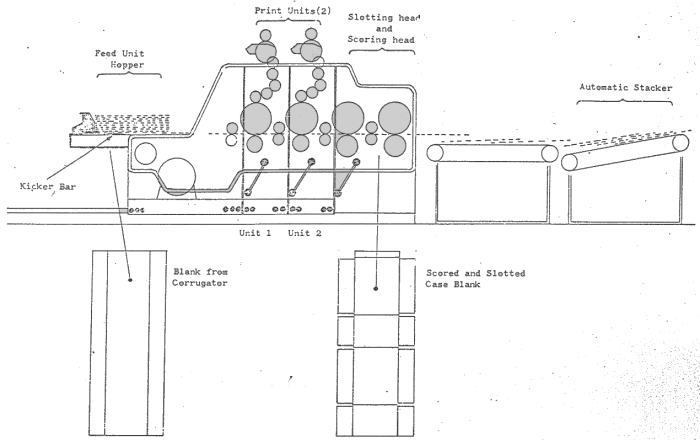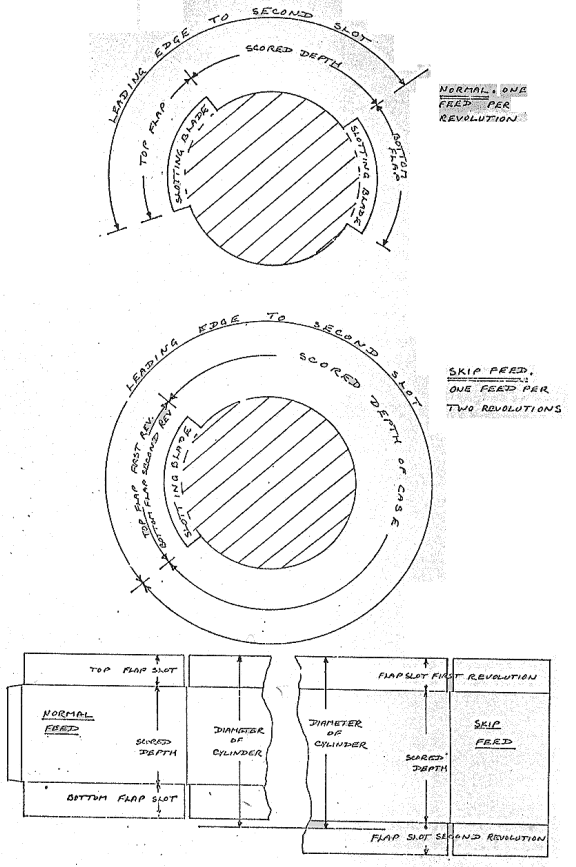Pkg Solutions
Quality Glossary
PRINTER-SLOTTER
Board from the Corrugator may be passed for conversion
to several different machines, Since the greatest volume of plant production
is made into four flap cases of the RSC / FEFCO 0200 series, a large part
of the corrugator output goes first to the Printer-Slotter in the form
of a blank, scored-first way.
The scores which are produced on the triplex unit define
the flaps and depth of the case, and the length of the blank is formed
into panels by the Printer Slotter.
These scored blanks are loaded into a hopper from which
they are fed into the machine from the bottom of the stack by means of
a kicker bar. This is set to push a single blank into the feed rollers
where it is gripped and carried into the printing section, see below.

Machines may have up to 4 sets of printing rollers,
and printing is formed by rubber dies, each carrying the impression required
for one particular color, and fed by rollers from a fountain at the top
of the machine. The flow of ink from the fountain can be regulated, together
with the ink rollers, to give an adequate supply of ink to the die according
to coverage required and the blanks are carried from one print section
to the next by deed rollers.
The blank is then fed through the slotting section which
consists of a pair of shafts, the top shaft carrying large bosses onto
which adjustable blades 6mm thick are attached. These blades are set to
cut slots into the area of the board, which form the flaps, missing the
center of the board, which forms the body of the case
The lower shaft carries bosses which are recessed to
take the slotting knife so ensuring a clean cut. On one side of the machine
the slotting head is equipped with knives which cut the stitching or gluing
flap at the end of the blank. The upper shaft is sometimes used to carry
head s on which pre- shaped tools are fixed for cutting out hand holes
in the case panels, in suet instances the bottom shaft has a boss carrying
an anvil, generally of hard rubber or similar material. Note On some Printer
Slotters the slotting operation comes last.
The final operation is the scoring of the blank between
the slots on top and bottom flaps and the trimming to size and this is
done by a further set of shafts carrying bosses which are Contoured to
give a clean breakdown on the corners of the case.
The blank is finally passed onto a take off belt or
automatic stacking device from which it is conveyed ready for the Joining
operation.
Very large machines have an average throughput of 2850
boards per hour with an average vetting up time of 40 minutes.
The average size machines can produce 5500 cases per
hour, the vetting up time being the same as on the large machines.
Smaller machines can run at 7000 cases per hour, again
with a 40-minute set up time.
Both overall speed and set up time are affected by excessive
print area, or cutting-out such as hand holing. The smaller machines lose
about 2000 blanks per hour on such operations.
Suction Feed. An alternative method of feeding blanks
into the machine is by suction feed mechanism pulling the scored and slotted
blank from the base of the hopper and transferring it into the feed rollers.
Stream feed is another way of supplying one blank.
Skip Feed. This is a method by which a larger blank
(width) can be kicked through the machine than would otherwise be possible.
The machine is set to accept one blank every two revolutions of the cylinders,
but care should be taken to ensure that the "leading edge to second
slot" measurement does not exceed the diameter of the cylinder otherwise
the slot will extend into the scored depth of the case. See diagram.

Some Printer Slotters have a limited die-cutting capability;
this is a achieved with a small rotary cutting-die. Stripping the waste
can be a problem, as often no true stripping section exists.
Modern machines have a pre-set facility in the box setting
section which allows the following job to be set up during a run and brought
into operation mechanically at the press of a button, rather than the
more time consuming set-up performed by hand.